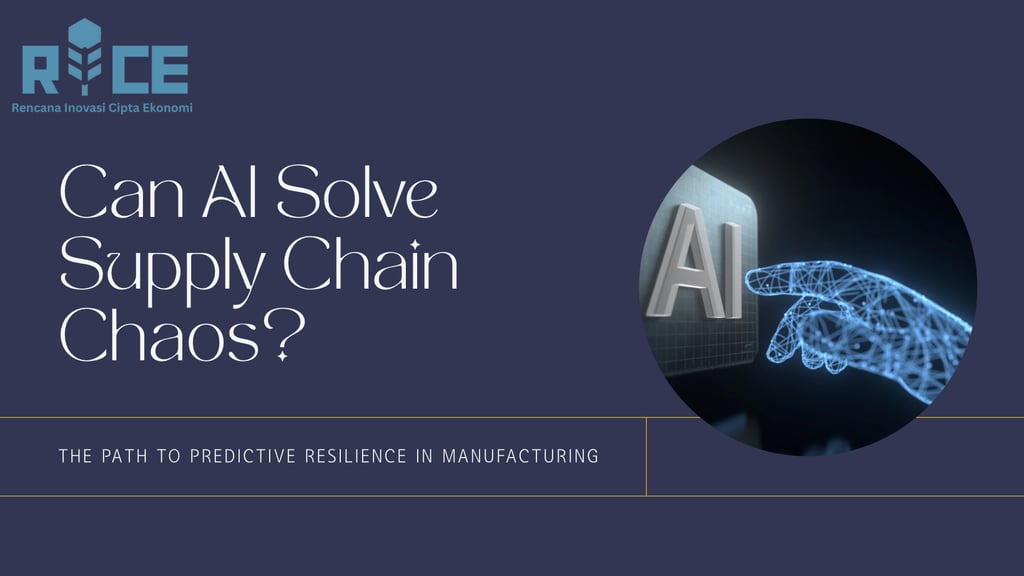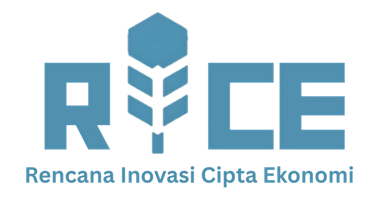Can AI Solve Supply Chain Chaos in Manufacturing? The Path to Predictive Resilience
Explore predictive analytics, real-time visibility, and automation to build resilient, efficient operations.
AI INSIGHT
Rice AI (Ratna)
10/7/20258 min read


The manufacturing sector has long been the backbone of global economies, but in recent years, its intricate supply chains have been subjected to unprecedented levels of disruption. From geopolitical tensions and trade wars to global pandemics and climate-related events, the constant onslaught of unpredictability has exposed critical vulnerabilities, leading to widespread chaos. This era of continuous turbulence compels us to ask a pivotal question: can Artificial Intelligence (AI) truly solve the complex riddle of supply chain chaos in manufacturing, transforming fragile networks into robust, resilient systems?
The answer, increasingly, points to a resounding yes. AI is not merely a technological enhancement; it represents a fundamental paradigm shift in how manufacturing supply chains are managed, monitored, and optimized. It offers the ability to move beyond reactive firefighting to proactive, intelligent anticipation, identifying potential disruptions before they escalate and guiding decision-makers toward optimal outcomes. This deep dive will explore the multifaceted ways AI is poised to revolutionize manufacturing supply chains, fostering an era of unprecedented resilience and efficiency. We will examine the core challenges AI addresses, the specific applications driving change, the strategic considerations for successful implementation, and the transformative future it promises for the industry.
The Unfolding Crisis: Why Manufacturing Supply Chains Are So Vulnerable
Before delving into AI's solutions, it's crucial to understand the inherent fragilities that plague modern manufacturing supply chains. Decades of globalization, just-in-time inventory strategies, and cost-cutting measures have, inadvertently, created systems that are hyper-efficient but acutely susceptible to external shocks.
Legacy Systems and Data Silos
Many manufacturing organizations operate with a patchwork of legacy systems that were never designed for the interconnected, data-intensive demands of today's global economy. These disparate systems often lead to severe data silos, where critical information is isolated within departments or specific functions. This fragmentation prevents a holistic view of the supply chain, making it impossible to track goods in real-time, predict component shortages, or understand the cascading effects of a single disruption. Without integrated data, decision-making becomes reactive and often based on incomplete or outdated information, further exacerbating the chaos. The lack of a unified digital infrastructure is a foundational barrier to building genuinely resilient supply chains.
Geopolitical and Environmental Volatility
The past decade has illuminated the profound impact of global events on manufacturing. Geopolitical shifts, such as trade disputes, tariffs, and regional conflicts, can suddenly restrict access to vital raw materials or key markets. Simultaneously, the escalating frequency and intensity of natural disasters – from floods and earthquakes to extreme weather events – directly disrupt production facilities, transportation routes, and energy supplies. These external shocks are largely unpredictable and outside the direct control of individual manufacturers. Their ripple effects across complex, multi-tiered global networks can halt production lines, delay deliveries, and result in significant financial losses, demonstrating the urgent need for systems capable of adapting to such volatility. [Internal link: "Explore our insights on geopolitical risks in manufacturing."]
How AI Transforms Supply Chain Management
AI's power lies in its ability to process vast quantities of data at speeds and with insights far beyond human capacity. For manufacturing supply chains, this translates into unprecedented levels of foresight, visibility, and operational agility.
Predictive Analytics for Demand and Risk
One of AI's most impactful applications is in predictive analytics. Traditional forecasting methods often rely on historical data and linear models, which struggle to account for sudden shifts or black swan events. AI, utilizing machine learning algorithms, can analyze a multitude of variables simultaneously – historical sales, economic indicators, weather patterns, social media trends, news feeds, and even geopolitical sentiment – to generate far more accurate demand forecasts. This allows manufacturers to optimize inventory levels, reducing both costly overstocking and debilitating stockouts.
Beyond demand, AI excels at risk prediction. It can monitor thousands of data points across the supply chain to identify early warning signs of potential disruptions. For instance, AI algorithms can flag a supplier's financial instability, anticipate port congestion based on shipping data, or predict raw material price fluctuations by analyzing global commodity markets. By identifying these risks proactively, organizations can implement contingency plans, diversify suppliers, or reroute logistics before a minor issue spirals into full-blown chaos. Rice AI specializes in deploying advanced predictive models that integrate diverse data streams, providing manufacturers with critical foresight to navigate market uncertainties and operational challenges. Our solutions empower businesses to anticipate demand with unparalleled accuracy and mitigate risks effectively, turning potential disruptions into manageable events.
Real-time Visibility and Optimization
A common refrain among manufacturers is the "black box" problem: a lack of transparency into their supply chain beyond tier-one suppliers. AI-powered platforms dissolve this opacity by aggregating data from sensors, IoT devices, RFID tags, enterprise resource planning (ERP) systems, and transportation management systems (TMS) across the entire network. This creates a real-time, end-to-end digital twin of the supply chain, offering unparalleled visibility into the movement of goods, inventory levels at every node, and the status of production lines.
With this granular visibility, AI algorithms can continuously optimize various aspects of the supply chain. They can dynamically reroute shipments to avoid congested ports, recommend optimal production schedules based on material availability and demand, or reallocate inventory across warehouses to meet immediate needs. This continuous optimization minimizes delays, reduces transportation costs, and improves overall operational efficiency. Our Rice AI visibility dashboards provide a comprehensive, real-time view of your entire manufacturing ecosystem, enabling swift, data-driven decisions that keep your operations running smoothly.
Intelligent Automation and Autonomous Operations
AI is also a key enabler of intelligent automation, transitioning supply chain tasks from manual, human-intensive processes to highly efficient, automated workflows. Robotic Process Automation (RPA), often augmented by AI, can handle repetitive administrative tasks like order processing, invoice matching, and inventory updates, freeing human personnel for more strategic work.
Moving beyond administrative tasks, AI drives autonomous operations in physical spaces. In smart factories, AI-driven robots collaborate with humans, performing assembly, quality control, and material handling with precision. Autonomous guided vehicles (AGVs) and autonomous mobile robots (AMRs) navigate warehouses, optimizing storage and retrieval. These technologies reduce labor costs, improve safety, and significantly increase throughput, contributing to a more resilient and efficient manufacturing process that can operate with fewer human touchpoints when necessary.
Implementing AI: Key Considerations and Best Practices
While the potential of AI is immense, successful implementation in complex manufacturing environments requires strategic planning and careful execution. It's not just about deploying technology; it's about transforming processes, culture, and data infrastructure.
Data Infrastructure and Quality
The foundational requirement for any successful AI initiative is robust data infrastructure and high-quality data. AI models are only as good as the data they are trained on. Manufacturers must invest in establishing centralized data lakes, integrating disparate systems, and implementing data governance protocols to ensure data accuracy, completeness, and consistency. This often involves cleaning historical data, establishing new data collection methodologies, and adopting sensor technologies to capture real-time operational insights. Without a clean, accessible, and comprehensive data foundation, AI applications will struggle to deliver their promised value, leading to poor insights and unreliable predictions. Building this foundation is often the most challenging, yet most critical, first step.
Phased Adoption and Scalability
Attempting a "big bang" implementation of AI across an entire manufacturing supply chain is often fraught with risk. A more pragmatic approach involves phased adoption, starting with pilot projects in specific areas with clearly defined objectives and measurable KPIs. This allows organizations to demonstrate early wins, build internal expertise, refine processes, and gather valuable feedback. Once the value is proven, these solutions can then be scaled across other departments, plants, or supply chain tiers. Scalability is also crucial from a technology perspective; chosen AI solutions must be flexible enough to integrate with existing systems and grow with the evolving needs of the business, without requiring complete overhauls every few years. Rice AI advocates for a strategic, phased deployment of AI solutions, ensuring that each stage delivers tangible ROI and builds organizational confidence. Our scalable architecture is designed to grow with your business, providing adaptable solutions that evolve as your supply chain needs change.
Human-AI Collaboration
A common misconception is that AI will replace human roles entirely. In reality, the most effective AI implementations foster a powerful synergy between human intelligence and artificial intelligence. AI excels at crunching numbers, identifying patterns in massive datasets, and automating repetitive tasks. Humans, on the other hand, bring invaluable experience, intuition, critical thinking, and the ability to handle ambiguity and adapt to truly novel situations. The goal of AI in manufacturing supply chains is to augment human capabilities, providing better tools for decision-making, reducing cognitive load, and enabling strategic focus. Training programs are essential to upskill the workforce, teaching them how to interpret AI insights, interact with AI systems, and leverage AI as a powerful co-pilot in their daily roles. This collaborative model ensures that the benefits of AI are fully realized while maintaining a skilled and engaged workforce.
The Future of Manufacturing: Resilient, Agile, and AI-Powered
The integration of AI into manufacturing supply chains isn't just about solving current problems; it's about building the foundation for a future where disruption is anticipated, mitigated, and even capitalized upon.
Building Proactive, Self-Healing Supply Chains
Imagine a supply chain that doesn't just react to disruptions, but proactively senses them, predicts their impact, and even self-corrects. This is the vision AI makes possible. By continuously monitoring global events, supplier performance, logistics networks, and internal operations, AI can identify nascent threats – a surge in a specific component's price, a labor dispute at a key port, an emerging weather pattern – and immediately model potential impacts. More importantly, it can then suggest optimal mitigation strategies, such as rerouting orders, shifting production to alternative plants, or engaging backup suppliers. In some advanced scenarios, AI-driven systems could even execute these contingency plans autonomously, creating a "self-healing" supply chain that maintains continuity with minimal human intervention. This shift from reactive to proactive and ultimately, autonomous resilience, fundamentally redefines operational stability.
Strategic Advantage Through AI Adoption
For manufacturers, embracing AI in their supply chains moves beyond mere problem-solving; it becomes a significant source of strategic competitive advantage. Companies that master AI will achieve superior operational efficiency, significantly reducing costs associated with waste, excess inventory, and expedited shipping. They will also gain unparalleled agility, able to pivot quickly in response to market changes or unexpected events, outmaneuvering less adaptable competitors.
Furthermore, AI contributes to enhanced customer satisfaction through improved order fulfillment rates and more reliable delivery times. It can also drive sustainability initiatives by optimizing logistics to reduce fuel consumption and minimizing waste through precise demand forecasting. As a leader in AI-driven solutions for manufacturing, Rice AI empowers organizations to unlock these strategic advantages. Our commitment is to partner with you, helping to design and implement AI frameworks that not only mitigate chaos but also transform your supply chain into a dynamic engine of growth and competitive differentiation. The manufacturers who invest strategically in AI today will be the leaders of tomorrow, characterized by their resilience, efficiency, and unwavering ability to deliver value in an ever-changing world.
Conclusion: Embracing the Intelligent Evolution
The question "Can AI solve supply chain chaos in manufacturing?" is no longer a matter of theoretical debate. The capabilities of artificial intelligence are demonstrably transforming how goods are produced, moved, and delivered, offering a potent antidote to the volatility that has plagued the industry. From hyper-accurate demand forecasting and real-time visibility to intelligent automation and proactive risk management, AI provides the tools necessary to dismantle the root causes of chaos and build truly resilient, agile, and efficient supply chains.
The journey towards an AI-powered supply chain is not without its challenges, particularly regarding data infrastructure and the need for new skill sets. However, the benefits – reduced costs, enhanced customer satisfaction, increased agility, and profound competitive advantage – far outweigh these hurdles. Manufacturers who embrace this intelligent evolution will transition from being victims of disruption to masters of their destiny, capable of navigating complexity with unparalleled foresight and control. The future of manufacturing is not just AI-augmented; it is AI-driven, a future where chaos is tamed, and resilience is engineered.
Ready to transform your manufacturing supply chain from chaotic to controlled, from reactive to resilient? Don't just adapt to the future; build it with intelligent innovation.
#AISupplyChain #ManufacturingAI #SupplyChainChaos #Industry40 #DigitalTransformation #SmartManufacturing #PredictiveAnalytics #SupplyChainResilience #AIinManufacturing #LogisticsTech #OperationsOptimization #FutureOfManufacturing #RiceAI #Automation #ManufacturingInnovation #DailyAIInsight
RICE AI Consultant
To be the most trusted partner in digital transformation and AI innovation, helping organizations grow sustainably and create a better future.
Connect with us
Email: consultant@riceai.net
+62 822-2154-2090 (Marketing)
© 2025. All rights reserved.


+62 851-1748-1134 (Office)
IG: @riceai.consultant
